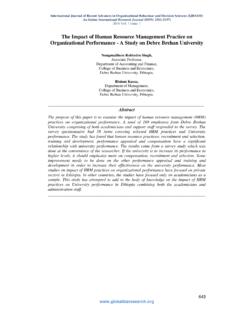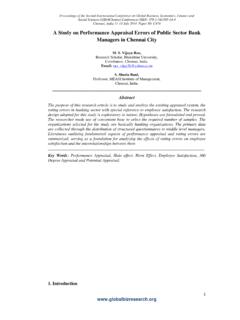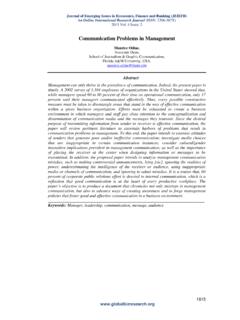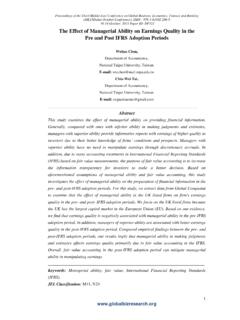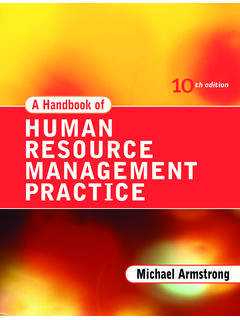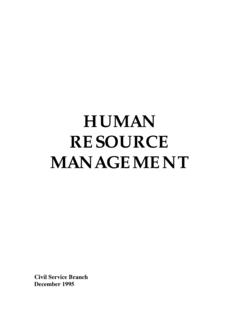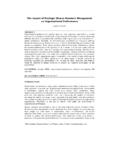Transcription of Strategic Human Resource Management and …
1 Proceedings of the Third Asia-Pacific Conference on Global Business, Economics, Finance and Banking (AP15 Singapore Conference) ISBN: 978-1-63415-751-3 17-19 July 2015 Paper ID: S502 1 Strategic Human Resource Management and Theoretical Background: A Critical Review Perspective Sajeevanie, Faculty of Management studies and Commerce. University of Sri Jayewardenepura, E-mail: _____ Abstract Wright et al. (1992) have mentioned that the field of Strategic Human Resource Management (SHRM) is lack of a strong theoretical foundation. Resource Base View (RBV) and there are some other theories which are relevant to the area of SHRM. The literature on HRM and performance can be divided into three main kinds of theories; Universalistic, Contingency and Configurationally (Gooderham et al.)
2 , 2008). Wright et al. (1992, ) have mentioned that one of the original and more popular theoretical models used in the SHRM literature is the Behavioral Perspective . As they explained, this theory focuses on the mediator effect on the relationship between strategy and firm performance. On the other hand the agency/transaction cost theory approach to examining the problems of Human exchange are based in the fields of finance and economics. According to Universalist principles there is a universal prescription or one best way or a general pattern. Another important issue is although the best practice approach has considerable support, this approach is also criticized by different perspective in the literature. Meanwhile the contingency school has criticized best practice.
3 However it is clear that there is no universal prescription of SHRM practice that should be employed in each different context. In contrast to the Universalistic or best practice approach, the best fit approach adopts a contingency approach. The linkage between strategy and HRM has received extensive attention from contingency school of through. After considering all of the relevant theories it can be concluded that the highly relevant theory for SHRM research is RBV while other theories do facilitating and supporting. _____ Key Words: Strategic Human Resource Management , theory, Resource Base View JEL Classification: C 19, G13, G 14 Proceedings of the Third Asia-Pacific Conference on Global Business, Economics, Finance and Banking (AP15 Singapore Conference) ISBN: 978-1-63415-751-3 17-19 July 2015 Paper ID: S502 2 1.
4 Introduction Today, Human Resource Management (HRM) has become more important to Strategic Management , mainly as a result of its role in providing competitive advantage and the rush to competitiveness. According to Wright, Dunford and Snell (2001) HR practice could not form the basis for sustainable competitive advantage but Human capital pool has greater potential to constitute a source of sustainable competitive advantage. Wright et al. (2001) have explained Human capital pool means skillful employees in the organization. With this rapid development of the globalized economy, both practitioners and academics have identified the importance of Human factor for the success of an organization. Human Resources are seen as the available talents and energies of people to an organization as potential contributors to the creation and realization of the organization s mission, vision, strategy and goals (Jackson & Schular, 2000, ).
5 SHRM is becoming ever more popular. According to Jain (2005) SHRM is not a completely new and revolutionary field rather its roots can be traced back to the mid 1950s. More specially, the birth of Strategic Human Resource Management (SHRM) came in the early 1980 s with Devanna, Fombrum and Tichy s (1984) article devoted to extensively exploring the link between business strategy and HR (Wright et al., 2001). Theory on the relationship between HRM and economic success has grown significantly over the past 15 years (Chang at el., 2005). This theoretical progress can be seen in two different arenas: meta theories describing broad rationales for why HRM and economic success should be linked, and middle level process theories describing how this linkage takes place (Wright, 2005).
6 In the first arena, the state of theory in SHRM research, was at best borrowing meta theories from other disciplines, and at worst almost completely a theoretical. The theories that used at that time were Resource based theory, the behavioral approach, open systems theory, and control theory with a few authors exploring population ecology and critical theory (Wright, 1992). After several years Wright, 1992, had mentioned that the Resource - based theory of the firm had become almost the universally embraced meta-theory among SHRM researchers, largely because of both its popularity in the broader Strategic literature, and its ability to articulate why HRM could be linked to the economic success of firms (Wright, 2005). A good theory enables one to both predict what will happen given a set of values for certain variables and to understand why this predicted value should result (Wright & Mcmahan, 1992).
7 An accurate theoretical model allows for better decision making in conditions of uncertainty. Due to the applied nature of SHRM it is exceedingly important that the field develop use theoretical models that allow for both predicting and understanding the effects of HR practices on organizational functioning (Wright et al., 1992). Much of the writing in the field of SHRM has been concerned with either practical advice or presentation of empirical data. Without having a good theory, the field of SHRM could be characterized as Proceedings of the Third Asia-Pacific Conference on Global Business, Economics, Finance and Banking (AP15 Singapore Conference) ISBN: 978-1-63415-751-3 17-19 July 2015 Paper ID: S502 3 a Plethora of statements regarding empirical relationships and/or prescription for practice that fail to explain why these relationships exist or should exist.
8 Theories assumes a somewhat rational, proactive decision making process as the major influence on the development and alignment of various HRM practices. Also these theories seem to be the most useful for examining SHRM because they attempt to predict (Wright et el., 1992). Some writers have argued that lack of any theoretical foundation for describing the SHRM function in organization (Delery & Doty, 1996). But Wright et al. (1992) have mentioned that this is valid a few years ago. Further they have mentioned that recent SHRM scholars have relied on various theories from the organizations literature as a basis for developing a more fully articulated theory of Human Resource Management . 2. Kind of Theories (Universalistic, Contingency and Configurationally Theories Agency/Transaction Cost Theory) The literature on HRM and performance can be divided into three main kinds of theories universalistic, contingency and configurationally (Gooderham et al.)
9 , 2008). Wright et al. (1992, p. 303) have mentioned that One of the original and more popular theoretical models used in the SHRM literature is the Behavioral Perspective . As they explained, this theory focuses on the mediator effect on the relationship between strategy and firm performance. As Wright et al. (1992, p. 305) empathies Another set of popular theoretical models being applied to SHRM research is the use of cybernetic systems models . An agency/transaction cost theory approach to examining the problems of Human exchange are based in the fields of finance and economics (Wright et al., 1992, p. 308). The implications of the institutional perspective for SHRM are important (Wright et al., 1992, p. 314). The best practice approach to managing people is based on Universalist principles that assume some HRM practices are appropriate for all organizations (Armstrong, 2009).
10 According to this there is a universal prescription or one best way or a general pattern that can be adopted by various organizations to manage their people, without considering organizations circumstances. Another important issue is although the best practice approach has considerable support, this approach is also criticized by different perspective in the literature. Further, the Resource based view Purcell (1999) argues that organizations should use their resources, including intangible assets such as Human resources to promote their overall model and to be better than their competitions. Another important part to be mentioned here is the contingency school has criticized Best practice. However it is clear that there is no universal prescription of HRM practices that should be employed in each different context.
